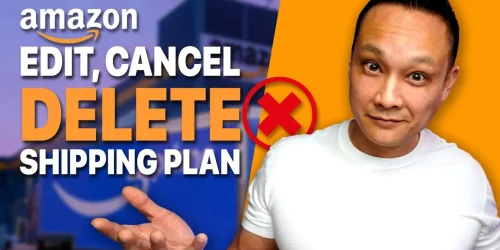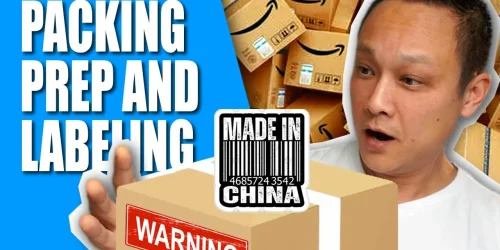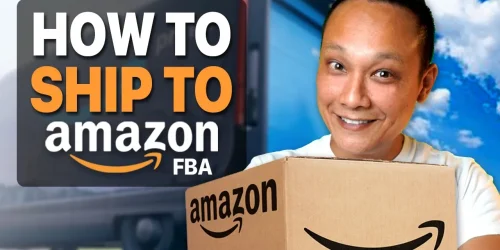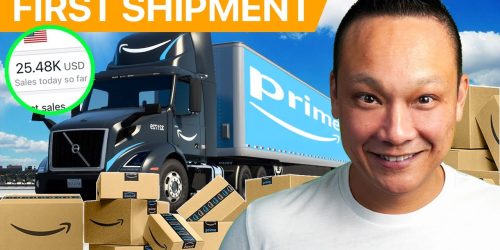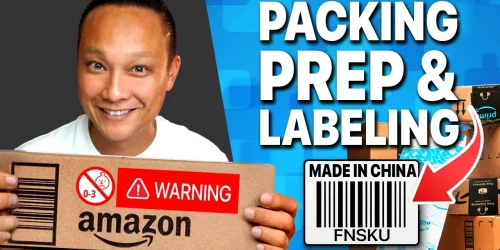How to Ship from China to Amazon FBA Explained
Shipping products from China to Amazon FBA can be one of the most challenging steps for new Amazon sellers. From understanding Amazon’s rules, labeling requirements, and federal import/export regulations to dealing with multiple parties and logistics, it’s a process with many moving parts. In this guide, I’ll break down the entire process from end-to-end so you can get your products from China to Amazon FBA quickly, efficiently, and without costly mistakes.
Overview of the Shipping Process
The shipping journey for your products from China to Amazon FBA warehouses generally involves three main phases:
1. Getting products to the local port in China: This may involve train, truck, or even air transport from the supplier’s warehouse to the port.
2. Crossing the ocean to the U.S.: Shipment moves by sea (typically slower and cheaper) or air (faster but more expensive).
3. Transporting from the U.S. port to Amazon: Once in the U.S., goods are delivered to Amazon’s FBA warehouses by air, train, or truck.
For a quick start, it’s often recommended to ship a small quantity by air (7-10 business days) to start selling sooner. If you’re moving large quantities or heavier items, sea shipping may be a better, cost-effective choice (3-8 weeks).
The Players in the Shipping Process
There are several parties involved in getting your products from China to Amazon:
• Supplier: Manufactures your product and sometimes handles basic shipment setup.
• Freight Forwarder: Manages the entire shipping process, from paperwork to coordinating with customs brokers and carriers.
• Customs Broker: Ensures all import/export documents are in order and handles duties and fees on your behalf.
• Shipping Carrier: Transports the goods, whether by sea or air.
A freight forwarder can coordinate these parties and streamline the process, ensuring all necessary paperwork is completed, fees paid, and logistics arranged.
Shipping Terms to Know: Incoterms
When shipping from China, you’ll encounter Incoterms—shipping terms that define who’s responsible for which part of the shipping process. Here are the three most common Incoterms for Amazon FBA:
Incoterm Description EXW (Ex Works) Supplier only prepares the product for pickup; you arrange everything else. FOB (Free On Board) Supplier transports goods to the Chinese port; you handle it from there. DDP (Delivery Duty Paid) Supplier takes care of everything, including duties, paperwork, and delivery to Amazon.
For beginners, DDP is often the easiest and most reliable option, as the supplier or freight forwarder manages the entire shipment process to Amazon.
Two Shipping Strategies: Direct to Amazon vs. Using a 3PL
Let’s look at the pros and cons of the two main strategies for shipping from China to Amazon FBA.
- Shipping Directly from Supplier to Amazon FBA
This strategy is generally the fastest and least expensive since your products go directly to Amazon without extra handling or storage costs.
Benefits:
• Reduced Costs: No 3PL fees, and fewer handling fees.
• Faster Shipping: No extra stops, so products arrive at Amazon sooner.
Requirements:
When shipping directly to Amazon, ensure all products are properly prepped and labeled. This includes:
• Product Labels: Every unit must have an Amazon FNSKU barcode.
• Additional Labels: Any mandatory labels like warnings, expiration dates, and country of origin.
• Correct Packaging: Each box should be labeled and meet Amazon’s packaging standards.
Considerations:
• Amazon Storage Limits: New sellers may face storage restrictions. Check your capacity in Seller Central under Capacity Monitor.
• Inventory Placement Fees: Amazon may require you to ship to multiple warehouses. Fewer warehouses can mean higher placement fees.
No. of Warehouses Estimated Placement Fee 5 No additional fee 3 Lower fee 1 Highest fee
For detailed steps on creating a shipping plan, which is required for direct-to-Amazon shipping, refer to the Amazon guide linked at the end of this post.
- Shipping from China to a 3PL (Third-Party Logistics)
A 3PL acts as a storage and logistics partner, allowing you to hold your inventory until you’re ready to ship to Amazon. This strategy is useful if you don’t have enough Amazon storage capacity or want to manage inventory more flexibly.
Benefits:
• Additional Storage: A 3PL offers more affordable storage than Amazon, especially during peak seasons when Amazon storage rates are higher.
• Flexible Inventory Management: You can send smaller batches to Amazon as needed, which can help maintain storage limits.
• Quality Control: A 3PL can inspect and label items, providing a backup quality check before shipping to Amazon.
Storage Costs January – September October – December Amazon FBA $0.78 per cubic foot $2.40 per cubic foot 3PL Generally cheaper Cheaper than Amazon FBA during Q4
Cons:
• Additional Fees: You’ll pay for storage, inspection, and handling services.
• Increased Handling: Extra transit time (1-2 weeks) to reach Amazon FBA from the 3PL.
For added security, have an inspection completed before products leave your supplier to minimize issues.
Step-by-Step Guide to Shipping from China
Now, let’s dive into how to execute these shipping strategies.
-
Direct Shipping from China to Amazon
- Create a Shipping Plan: Go to Seller Central > Inventory > Send/Replenish Inventory to start a new shipping plan.
- Choose Shipping Option: • Amazon’s Partnered Carrier: Amazon negotiates rates with FedEx, UPS, or DHL, which may offer significant discounts. • Freight Forwarder: Compare quotes from freight forwarders for possible cost savings.
- Enter a “Ship From” Address: Enter a U.S.-based “Ship From” address if using a freight forwarder, ideally a California address for lower costs.
- Arrange Pickup and Delivery: Your forwarder or Amazon’s partnered carrier will arrange the pickup and transport to Amazon’s designated FBA warehouse.
- Label and Pack: Ensure that each unit and box is labeled and prepped according to Amazon’s guidelines to avoid penalties or delays.
-
Shipping to a 3PL from China
- Hire a Freight Forwarder: If your supplier doesn’t offer DDP shipping, a freight forwarder can arrange everything from the supplier’s warehouse to the 3PL.
- Select a 3PL Partner: Choose a 3PL with reliable reviews and the services you need, such as inspection, consolidation, or labeling.
- Create a Shipping Plan (3PL to Amazon): Only create a shipping plan once you’re ready to send inventory from the 3PL to Amazon.
- Communicate with the 3PL: Provide them with the shipping labels and any additional requirements for shipping to Amazon.
- Regularly Restock: Use the 3PL to store excess inventory and schedule shipments to Amazon to keep your inventory levels balanced.
Quick Comparison of Direct vs. 3PL Shipping
Feature Direct to Amazon 3PL to Amazon Cost Lower Higher due to storage fees Time Efficiency Faster Slower (extra handling) Storage Flexibility Limited to Amazon More flexibility Labeling Requirements Must be perfect 3PL can help with labeling Inspection Supplier or self Additional inspection at 3PL
Additional Tips for Successful Shipping
• Check Storage Limits Regularly: Ensure your inventory fits within Amazon’s storage limits.
• Use Amazon’s Partnered Carrier for Cost Savings: Amazon’s discounts on shipping can be substantial.
• Inspect Products Pre-Shipment: A final inspection at your supplier’s location can prevent issues and delays later.
Starting an Amazon FBA business involves careful planning and coordination, especially when dealing with overseas shipments. Whether you choose to ship directly to Amazon or use a 3PL, understanding each step in the shipping process and knowing when to enlist help from experts can save time, money, and headaches.

